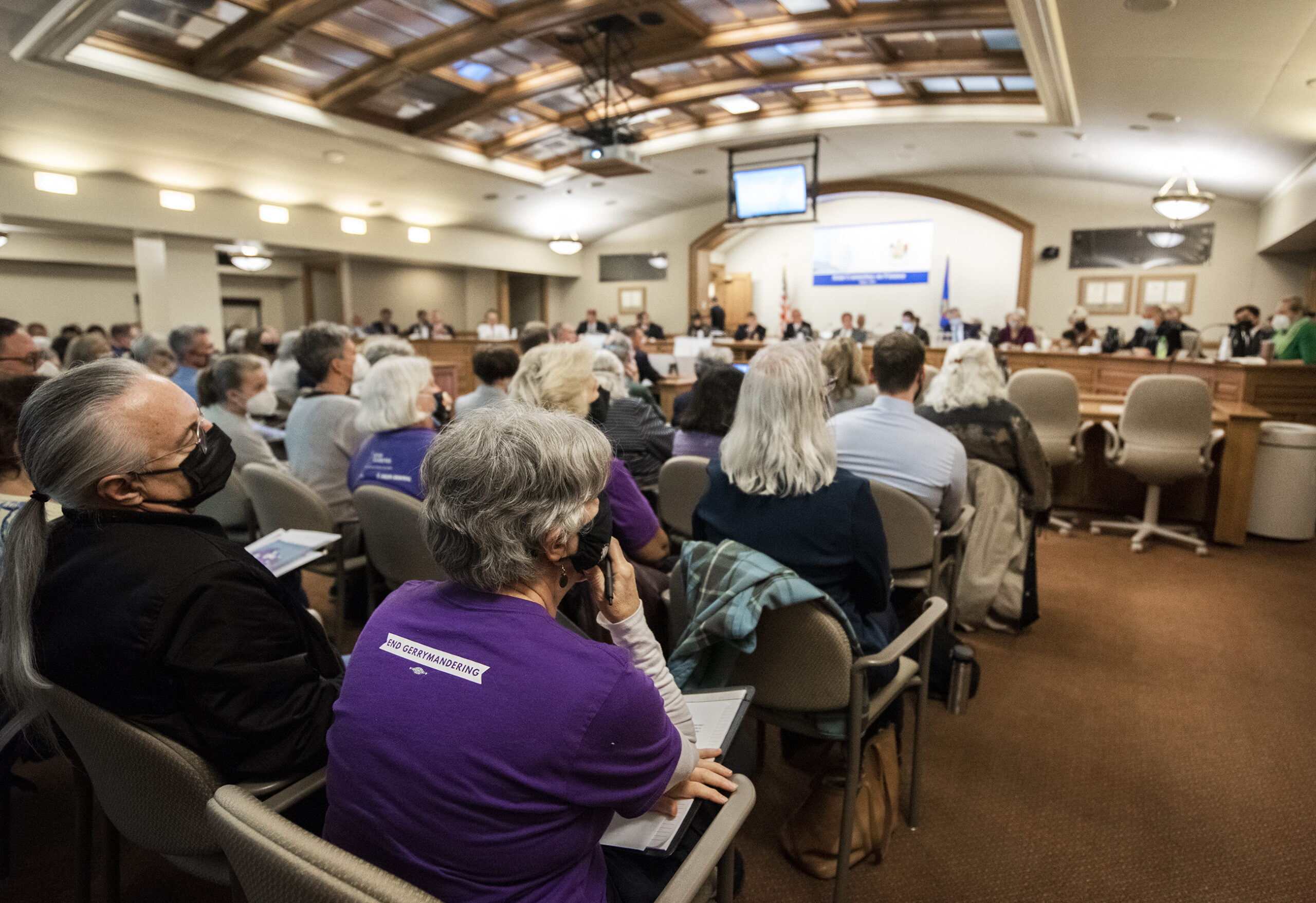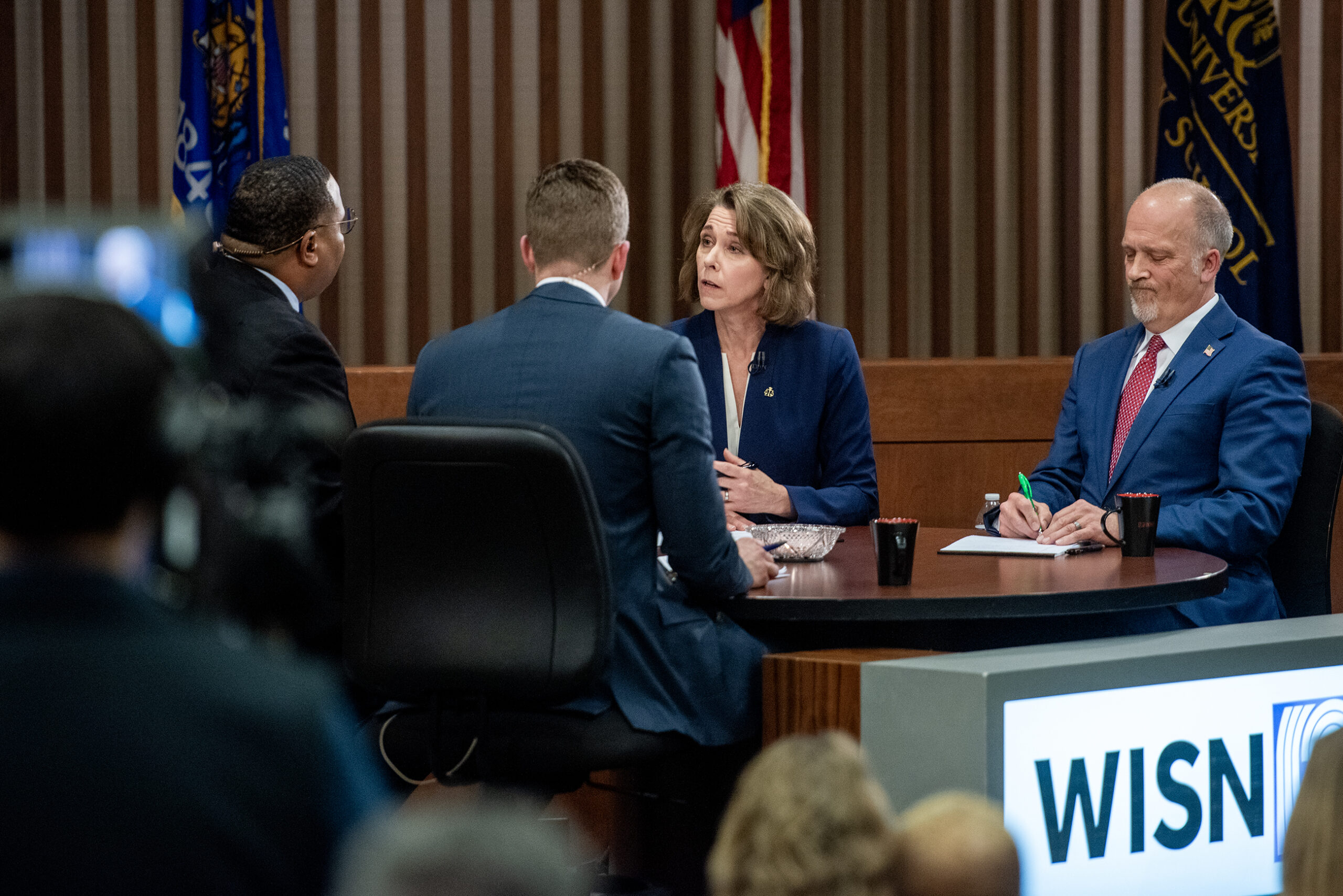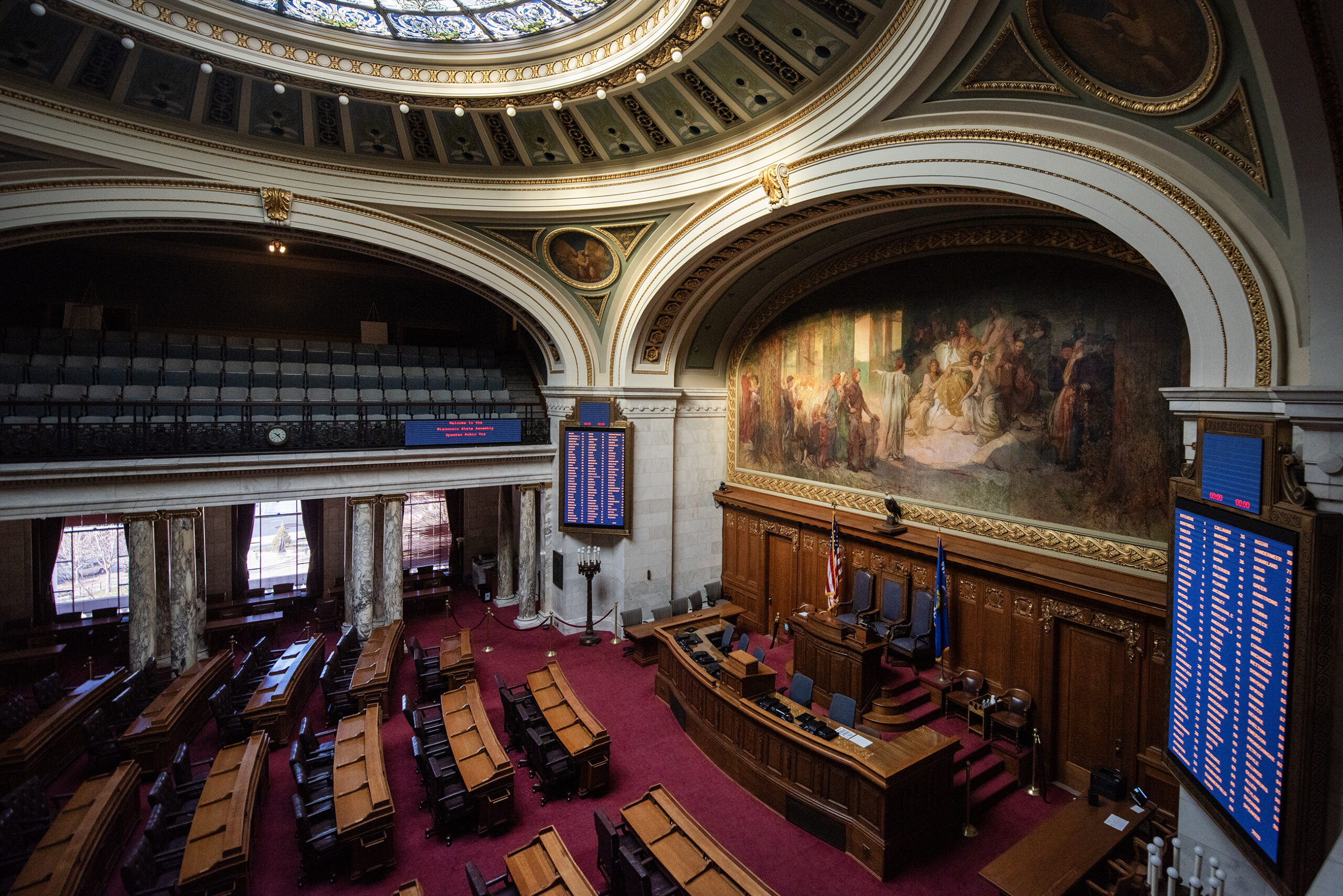There are times in modern politics when — and this is an understatement — it sounds like Democrats and Republicans are talking about completely different things. For instance, they could be debating a bill, and it sounds like they’re not even talking to each other. It’s as if they’re on different planets.
On its surface, the Oct. 28 public hearing on the Wisconsin Legislature’s proposed redistricting plan sounded like one of those times.
Robin Vos, the powerful Republican Assembly Speaker, testified in favor of maps his party has drawn to shape Wisconsin’s political boundaries for the next decade. The maps, Vos bragged, met all the legal requirements of redistricting, fulfilled a constitutional duty of the Legislature and should be passed.

Assembly Speaker Robin Vos speaks at the front of the chamber Wednesday, June 9, 2021, at the Wisconsin State Capitol in Madison, Wis.Angela Major/WPR
But when Democrats asked questions of Vos a pattern emerged. They wanted to talk about the old maps — the ones Republicans passed in 2011.
The story of the 2011 maps is well-known: Republican mapmakers worked from a private law firm across the street from the capitol, where they forced Republicans to sign nondisclosure agreements to look at their districts while Democrats were completely shut out.
As the public watched, state Sen. Jeff Smith, D-Eau Claire, took advantage of a rare opportunity to grill Vos, pressing the speaker about the secretive tactics from a decade ago.
“Since you signed a nondisclosure agreement in 2011,” Smith said, “can you talk about 2011 now?”
“I was not speaker,” Vos of Rochester replied. “I was not in charge of redistricting.”
State Sen. Kelda Roys, D-Madison, referred to the nondisclosure agreements as “secrecy oaths.”
“I just want to make sure that the record is clear that that did happen,” Roys said.
“Let me just correct that,” Vos shot back. “You are using terms meant to incite an opinion.”
More than an hour into the hearing, it was clear Vos had had it with talk of the old maps.
“You want to talk about the past,” he said. “I want to talk about the future.”
Although it seemed like one of those political moments where both sides are talking past each other, they were actually talking about the same thing. That’s because the new maps proposed by Vos and state Senate Republican Majority Leader Devin LeMahieu of Oostburg are based on the old maps.

Senate Majority Leader Devin LeMahieu, right, listens during floor debate Wednesday, June 9, 2021, at the Wisconsin State Capitol in Madison, Wis. Angela Major/WPR
While it may have been obscured by partisan bickering, this hearing raised an important question: Can the map that helped Republicans cement their majorities for the past decade be reused for the next 10 years?
‘Retain as much as possible’
Some of the procedural milestones in the current fight over redistricting were easy to predict well in advance. There was never any doubt Republicans would pass new maps, and they did. Likewise, Gov. Tony Evers had promised to veto Republican maps if they weren’t more competitive, and he did.
But before any of that happened, GOP lawmakers took another step that was less expected, but nevertheless made clear how they were approaching redistricting this year.
They introduced a joint resolution that spelled out their priorities for drawing maps. A joint resolution is not a bill, it can’t become a law, and in this case, it’s nonbinding. It’s the Legislature saying: “Here’s what we think.”
There wasn’t much debate on this resolution when it came up for a vote, and the only Republican to speak was Vos, who said it was the Legislature’s duty to handle redistricting.
“This resolution lays out the principles that we are going to utilize to ensure that we have a map that will last during the next 10 years just like the last one has during the past decade,” Vos said.
Among the priorities in the resolution were some required by the U.S. Constitution and federal law. Those included the principle of “one person, one vote” and compliance with the Voting Rights Act.
It also prioritized criteria that are required by the state constitution, including drawing districts that are compact and contiguous and avoiding splitting up local boundaries.

A map created by Republicans in the state Legislature is displayed during a hearing on Oct. 28, 2021, at the Wisconsin State Capitol. Sen. Jeff Smith sits on the left. Angela Major/WPR
But the Republican resolution also included redistricting criteria that are not required, like avoiding putting two incumbents in the same district, also known as incumbent pairing.
And — most notably — it endorsed another otherwise optional guideline. The GOP maps would “retain as much as possible the core of existing districts.”
In other words, Republicans were declaring as a policy of the Legislature that they would keep as much as possible of the map their party drew a decade ago.
Democrats like state Rep. Mark Spreitzer of Beloit weren’t happy.
“This latest resolution is just more of the same,” Spreitzer said. “Trying to cling to power and saying anything you can in order to come up with a justification for doing that.”
The Republican resolution passed the Senate and Assembly on party-line votes, and when Republicans released their maps in October, they were pretty true to its principles.
‘Gerrylaundering’
Because of that, the 2021 map looked a lot like the 2011 map. In the world of redistricting shorthand, this is often referred to as “core retention.” But Rob Yablon, University of Wisconsin-Madison law professor, has a different name for it: “gerrylaundering.”
“‘Gerrylaundering’ is an attempt to perpetuate an existing biased map by carrying forward the existing lines with as little change as you can get away with,” Yablon said.
The idea of core retention is not new in redistricting, but by no means is it a widely accepted norm.
Yablon found that of all 50 states, only three have laws or constitutional provisions that endorse core retention. Wisconsin is not among them.
It’s also not a principle Wisconsin Republicans prioritized in the very recent past. According to the nonpartisan Legislative Reference Bureau, the 2021 GOP maps retain about 92 percent of the existing Senate districts and 84 percent of the existing Assembly districts. By comparison, the 2011 GOP maps retained 88 percent of Senate districts and just 59 percent of Assembly districts.
Yablon said another sign of “gerrylaundering” is the way Republicans want to avoid pairing incumbents in their 2021 map.

Rob Yablon is a law professor at UW-Madison. Angela Major/WPR
Incumbents are “paired” when the lines are changed so that more than one sitting legislator ends up living in the same district. At that point, they’re faced with a choice if they want to stay in the Legislature: Either run against a colleague or move.
Because the state Legislature is full of Republicans, avoiding incumbent pairings is another way of protecting sitting GOP lawmakers. In other words, it means fewer of them are at risk of losing their jobs.
This isn’t unheard of in the world of redistricting, but it’s not a hard-and-fast rule. In Wisconsin, it’s not required by state law or the constitution, and Yablon’s research found several states actually ban mapmakers from favoring incumbents.
This is also a principle that Republicans didn’t follow ten years ago. In 2021, the Republican-drawn map would pair a total of six lawmakers, but in 2011, the map paired 24 of them.
“It’s clear that the goal for the Republicans in the Legislature is to carry forward as much of the existing gerrymander as they can,” Yablon said.
‘Least changes’
In 2020, Evers promised an alternative to the Legislature’s maps, drawn by a “People’s Maps Commission” he established through an executive order.
But the People’s Maps proposal, which was hotly debated on the floors of the Assembly and Senate, didn’t go anywhere. In fact, many Democrats voted against it in the Assembly, arguing it violated the Voting Rights Act by diluting majority-minority districts in Milwaukee.

Wisconsin Democratic Gov. Tony Evers signs an executive order creating a redistricting commission on Monday, Jan. 27, 2020, in Madison. Scott Bauer/AP Photo
In contrast, Republicans were united behind their redistricting plan, which passed along party lines.
They never referred to their plan as a gerrymander or called it “gerrylaundering,” but they did use a term to describe it that struck at a similar idea. They called it a “least changes” map. In other words, they said their plan would adjust the 2011 map for population changes and not much else.
There are obvious political reasons Republicans would want to do this. The last map helped them win big over the last decade, and it mostly survived multiple lawsuits. If the new map is going to be decided by a court — which it likely is — the old map is not a bad place to start.
But if you take a close look at the new GOP map, there are some places where it makes strategic changes that benefit Republicans.
“It’s very clear that they don’t change the districts that they like,” said John Johnson, redistricting expert and research fellow at Marquette University. “They do change the districts where they think that they can either pick off a Democrat or shore up a Republican who needs help.”
A good example of this is in Milwaukee’s suburbs, where there are communities that have been changing over the past decade. The only seats Democrats managed to flip under the old map are in these suburbs, which are really the only part of the map where Republicans are threatened.
One specific Senate district, and the three Assembly districts that are nested within, demonstrates the choices Republicans made with the new map.
The Senate district is currently held by Sen. Dale Kooyenga, R-Brookfield, who won his last election by just 2.4 percentage points. According to Johnson’s research, based on the average results of the 2020 presidential race, the 2018 governor’s race and the 2016 presidential race, Kooyenga’s district actually has a slight Democratic lean.
The corresponding Assembly districts include two of the only seats Democrats were ever able to flip in the last decade — currently held by Rep. Sara Rodriguez, D-Brookfield, and Rep. Robyn Vining, D-Wauwatosa. The third Assembly district is held by Rep. Joe Sanfelippo, R-New Berlin.
In the new map, Republicans would make tradeoffs. They’d make Vining’s Assembly district a lot more Democratic, all but guaranteeing Republicans would never win there.
But at the same time, the other two Assembly districts would get a lot more Republican. Rodriguez’s district would transform from a competitive seat to one that’s safely Republican. Sanfelippo’s district, which is already Republican, would get even more so.
Taken as a whole, Republicans would make a two-for-one deal with these Assembly districts, but the real prize for them would be in the Senate where Kooyenga’s seat would get safer.
That’s why Johnson says it’s wrong to call the latest Republican map “least changes.”
“Who cares about a ‘least changes’ map?” Johnson said. “Like no one actually believes that that matters … I struggle to even respond to that because I think it’s such a disingenuous point.”
When you look at all the changes on this map, based on Johnson’s analysis, on average, Republicans would be expected to win 63 seats in the Assembly, up from the 61 they hold now. In the Senate, Republicans would be expected to win 23 seats, up from 21.
That would leave Republicans just a few seats away from winning a two-thirds supermajority in the Legislature. That means if Republicans had a good election year, they could win enough seats in the Legislature to override a governor’s veto. GOP lawmakers could run things in Wisconsin, even more than they do now.
An unequivocal ‘yes’
But like everything connected to redistricting — especially this year — what’s OK and what’s not is really up to the courts, and a “least changes” map is at the heart of the redistricting case before the Wisconsin Supreme Court.
The case was brought by the Wisconsin Institute for Law and Liberty, a conservative law firm that files high-profile lawsuits with the state Supreme Court on a regular basis.
WILL argued that while it’s the Legislature’s job to redistrict, that’s unlikely to be successful under split government. So without a new map signed into law, WILL argued the next best alternative is the old map because it passed the Legislature, was signed by a governor, and already survived lawsuits.
Democrats lined up to fight the case, with a number of them filing briefs. Bill Whitford and other plaintiffs from Wisconsin’s famous redistricting case that went all the way to the U.S. Supreme Court accused conservatives of asking the Wisconsin Supreme Court to “do their dirty work.”
Opponents of the “least changes” argument have a couple reasons. For one, they don’t accept it as a valid legal principle for redistricting, with some pointing to Yablon’s research to back them up. Beyond that, Democrats say the approach isn’t fair because it could entrench the 2011 GOP gerrymander for another decade.
While the legal battle over redistricting isn’t over, on Nov. 30, the Wisconsin Supreme Court did answer this major question: Is a “least changes” map OK? And their 4-3 majority opinion said — unequivocally — yes.

The Wisconsin Supreme Court on Wednesday, June 9, 2021, at the Wisconsin State Capitol in Madison, Wis. Angela Major/WPR
Writing for the majority, conservative Justice Rebecca Bradley largely adopted WILL’s argument. Maps are political decisions, she wrote, and those are for the Legislature to make, not the court.
“Just as the laws enacted by the legislature reflect policy choices, so will the maps drawn by that political body,” wrote Bradley. “Nothing in the constitution empowers this court to second-guess those policy choices, and nothing in the constitution vests this court with the power of the legislature to enact new maps.”
The court also said it would not look at the partisan makeup of districts, meaning justices would not try to draw a map that’s more balanced. To do so, Bradley said, would be “decidedly nonjudicial.”
The court could have left it there, but justices kept going. Conservative justices said they would not decide any “partisan gerrymandering” cases. The U.S. Supreme Court closed the door to those cases in federal court in a landmark 2019 ruling. In its November ruling, the state Supreme Court was saying that partisan gerrymandering cases aren’t allowed in state court either.
Justice Brian Hagedorn, who everyone was watching as the court’s swing vote, mostly joined the majority opinion. Hagedorn said legislators are allowed to draw partisan maps, and it’s not the court’s place to make political judgments.
“As the majority opinion explains, the Wisconsin Constitution does not preclude the legislature from drawing districts with partisan interests in mind,” Hagedorn wrote. “The petition here — that we should use our equitable authority to reallocate political power in Wisconsin — is not a neutral undertaking. It stretches far beyond a proper, focused, and impartial exercise of our limited judicial power.”
The case isn’t over. The court has tentatively scheduled up to a four-day hearing in January and still gets a chance to approve specific maps eventually. A federal court could also still weigh in.
But this ruling was, without a doubt, a huge win for Republicans, because the map they got to draw after they won big in the 2010 election — that helped them cement their majorities for a decade — could live on, until at least 2032.
Between now and then, lawmakers will come and go. The political pendulum will swing, but maybe not in the Legislature.
This story is part of “WPR Reports: Mapped Out,” a podcast about redistricting in Wisconsin. Never miss an episode by subscribing now on your favorite podcast app or at wpr.org/mappedout.
Wisconsin Public Radio, © Copyright 2025, Board of Regents of the University of Wisconsin System and Wisconsin Educational Communications Board.





